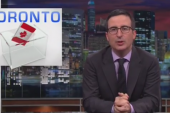
Two discussions during Wednesday’s Toronto Transit Commission’s monthly meeting were interesting, even if, in the end, both were deferred. The first concerned procuring 126 articulated buses (the longer ones with what looks like an accordion that bend in the middle) that will lead to longer wait times. This discussion parallels the kind of thinking we’re seeing in streetcar changes, a type of compromise between service and operation cost. The second, taking up the bulk of the meeting and creating some real drama, was about settling the Gateway Newsstands contract debacle. Misconceptions about this process have been rampant, and clarification is in order.
Andy Byford, the CEO of the TTC, listed the advantages of articulated buses in a presentation. They hold 72 people instead of 52. There’s more open space, meaning more room for luggage or strollers. They deal efficiently with surges of people in high-demand corridors. In essence he said that a bigger bus is more spacious, which is hardly a revelation, but there was considerable nuance involved too. Fascinating statistic: 16-20% of each bus’s route time is spent on passengers getting on and off–articulated buses would have three “proof of purchase” entrances to expedite boarding.
But there are drawbacks. The worst by far is that introducing articulated buses means there will be fewer buses on the road, and therefore more time in between buses. However, these buses would only be used where there are tons of people, where buses already come frequently. Byford thinks the wait time increase here will often be “imperceptible.” In peak time, a two minute and a bit wait might become three and a bit, et cetera. Non-peak time is another story. Byford mentioned that they aren’t terrific in snow, though immediately mentioned that cities like Calgary, Edmonton, Montreal , New York, and Ottawa all have them. Only once in six years did Calgary have to remove their articulated fleet off the road, and that was in a huge storm. Still, hearing Byford speak about the TTC is like Bob McKenzie on hockey–they both are privy to advanced stats most observers don’t even know are measured. If Byford is sacrificing wait times to decrease operation costs, it isn’t from a place of ignorance.
However, not everyone was convinced of Byford’s plan. A citizen named Allen, who attends every monthly transit meeting, presented his own PowerPoint lecture to counter. He stated that most citizens only care when the bus arrives, not how big it is once there. Fair enough. He told me after the meeting that, despite the way it was pitched, this was pushed by Mayor Ford and councillor Minnan-Wong years ago as a way to cut back on operating costs, not to improve services. Byford did speculate, almost fantasized, about either parlaying the nine million elsewhere in the TTC system or using it to balance the budget. Perhaps it’d be easier for passengers to wait for these fewer but larger buses and the savings they represent if there was an assurance it would only be an extra minute, and if buses stuck strictly to their schedules in the first place. Nobody opposes more space and savings, but I also doubt there are complaints about too many buses.
****
Background on the Gateway Newsstands: These are the kiosks inside about 65 subway station. The company has partnered with the TTC now for 19 years. In January of this year the TTC agreed to extend their lease another 15 years after “lengthy negotiations.” Gateway Newsstands’ rent will increase by 65%, and on top of paying the city a $1.5 million signing bonus they are willing to undertake $1.5 in capital investments. At the time, Mayor Ford criticized TTC Chair Karen Stintz for not putting the process out to tender, calling it a sole-sourced deal, and claimed that if other companies were consulted they would have given the city a better deal. Doug Ford chirped that “this is what happens from a person in my opinion that has never run a business in their entire lives chairing the TTC.” Stintz claimed that Ford just “didn’t know the details.”
In Wednesday’s meeting the executives from Gateway Newsstand explained that they had to pay for the moving of their kiosks to other locations within the station, and that as their lease was expiring they became unwilling to take on this expense without knowing they’d be there to recoup their investment. Their contract was to end in 2014, but the city needed certain stations renovated to install handicap facilities (at a cost of $80-100,000, depending on the station’s particularities) in advance of the 2015 Pan Am Games. Therefore, the TTC came to Gateway Newsstands in order to get this done, not the other way around. As TTC commissioner councillor Parker put it, the meeting was about determining “who invited who to the dance.”
Gateway Newsstands executives said nothing they did was untoward, and presented the context of their negotiations in a light that surprised Byford’s TTC team. Negotiations began as early as 2008, and Gateway Newsstands has a paper trail of over 70 communications they’ve made available to the TTC. Their past negotiation was conducted in a similar way. The terms of the negotiations were made public only after the agreement was reached, and therefore a company claiming they’d have given the city a better offer unfairly has the benefit of knowing what the offer was. Part of the deal was based on Gateway Newsstands’ experience and expertise as TTC suppliers, and also the disruption that would be caused in TTC stations if another company were to get the contract.
The TTC executives claimed that the people who Gateway Newsstands negotiated with originally are retired. They admitted that it’s “not remarkably common,” though not impossible, for the city to negotiate a deal, arrive at an agreement, disclose the terms, and then put the commission out to tender again.
Over 50 Gateway Newsstands employees and kiosk owners attended Wednesday’s meeting wearing pins urging the TTC, “Don’t take my business!” Every seat in the room was taken, and people were standing. The commission heard stirring, if redundant, appeals from several of them, all immigrants with children who will lose their family’s only source of income if the Gateway Newsstands agreement is rescinded. 400 Gateway staff and up to 1000 suppliers stand to lose their jobs.
In light of the two different versions of the facts, Byford said he would like the time to absorb them both and get the facts straight, and the commission agreed this was prudent and voted to defer. Though they entered the room fearing they’d become “the victim of a political hotbed issue,” this meeting gave Gateway Newsstands employees and executives satisfaction. At least for now.
____
Jeff Halperin is a Toronto-based writer. You can follow him on Twitter @JDhalperin.
For more, follow us on Twitter @TorontoStandard and subscribe to our newsletter.














